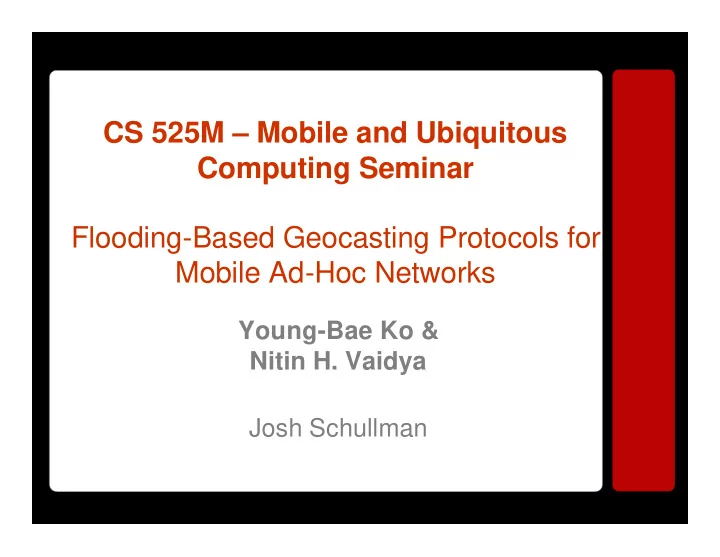

CS 525M – Mobile and Ubiquitous Computing Seminar Flooding-Based Geocasting Protocols for Mobile Ad-Hoc Networks Young-Bae Ko & Nitin H. Vaidya Josh Schullman
Introduction • MANETs (Mobile Ad-hoc NETwork) – Like any ad-hoc network, no fixed network architecture – Scenarios for ad-hoc networks include search-and- rescue, friend-or-foe recognition, home networking, file sharing, etc. • http://computer.howstuffworks.com/mote.htm • http://www.kazaalite.com • Multicasting – Commonly used in wired/wireless environments to distribute data to multiple recipients – Cheaper than establishing multiple unicast sessions (esp. in MANET topologies) – MANET multicasting difficult due to constant topology changes
Multicasting, Geocasting • Multicasting – A multicast group shall be defined as a collection of nodes. Nodes that which to participate in a multicast shall be required to explicitly register to the group prior to participation. • Geocasting – Variation of multicasting; used to propagate data to several nodes in a specified geographic (or geocast ) region (i.e., geocast group ) – Implicit group joining – dependent on node position at time of geocast. – All nodes shall know their geographic location (GPS-based)
Concept - Geocast Flooding • Simplest approach to multicasting • Applied to geocast groups/regions… if (node ∈ geocast_region) accept_packet(); endif if (packet_is_new) broadcast_to_neighbors(); endif
Concept – Forwarding Zone • Nodes forward packets if they are contained in the forwarding zone • Goal – increase probability of delivery while reducing transmission overhead • Applied to geocast flooding… if (node ∈ geocast_region) accept_packet(); endif if (packet_is_new && (node ∈ forwarding_zone)) broadcast_to_neighbors(); endif
Geocasting Protocols • Flooding-based Geocasting (baseline) • Static Zone Scheme • Adaptive Zone Scheme w/one-hop flooding • Adaptive Distance Scheme
Static Zone Scheme • Forwarding zone: the smallest rectangle that includes current location of source S and the geocast region, such that the sides of the rectangle are parallel to the X (horizontal) and Y (vertical) axes. • Source coordinates included w/geocast packet • Static – forwarding zone never changes during propagation from node to node
Adaptive Zone Scheme • Similar to static zone scheme, except nodes replace source coordinates with current node • Can lead to poor performance with a less-than-optimal MANET topology if (node ∈ geocast_region) accept_packet(); endif if (packet_is_new && (node ∈ forwarding_zone)) replace_forwarding_zone(); broadcast_to_neighbors(); endif
One-Hop Flooding • In situations where topology is less than ideal, introduce one-hop flooding • Allows propagation of packet to nodes outside of forwarding zone • Greatly increases propagation probability if (node ∈ geocast_region) accept_packet(); endif if (packet_is_new && (node ∈ forwarding_zone)) replace_forwarding_zone(); broadcast_to_neighbors(); elif (packet_is_new) revert_forwarding_zone(); flood_to_neighbors(); endif
Adaptive Distance Scheme • Geocast packet includes: – Geocast region – Center of geocast region (X c , Y c ) – Source location (X s , Y s ) • Similar problems occur as with adaptive zone without one-hop flooding (e.g., ‘deadlock’) if (node ∈ geocast_region) accept_packet(); endif if (packet_is_new && (source_distance >= node_distance)) replace_node_location(); broadcast_to_neighbors(); elif (packet_is_new && (source_node ∈ geocast_region)) broadcast_to_neighbors(); endif
Simulation/Results • Basics – Number of nodes {10, 30, 50} – Node locality derived via uniform distribution – Mobility – determines direction, speed, distance • Region {1000, 1000} (X vs. Y) units • Maximum speeds {5, 10, 20} units/sec – Movement pause patterns {0, 1, 3, 5, 7, 9} sec – Transmission range (250 units) – Wireless link bandwidth (2 Mbps) • Simulation time varies inversely w/speed • Geocast packet generation every 1 sec per maximum speed of 5 units/sec – Geocast frequency proportional to speed • Geocast region defined {700,1000} ie, 300 units sq.
Geocast Delivery Metrics • Accuracy – the ratio of the number of group members that actually receive the geocast packet, and the number of group members which were in the geocast region at the time when the geocast delivery was initiated • Overhead – the average number of geocast packets received by each node per geocast
Results – Speed Variation
Results – Node/Pause variation
Conclusions • All proposed protocols result in significantly lower geocast overhead • It is possible to reduce overhead while still maintaining same level accuracy • Adaptive zone scheme w/one-hop flooding is optimal of proposed protocols
Recommend
More recommend